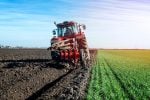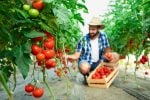In 2025, the world’s most successful farmers don’t just grow crops – they grow soil, moving away from conventional agriculture. While conventional farming continues its slow decline, a quiet revolution is taking place across fields worldwide. Farmers who’ve switched to regenerative agriculture are reporting 20-30% higher yields with 50-70% less chemical input costs. This isn’t just better farming – Regenerative agriculture practices are better business.
The success stories are piling up across every growing region and farm type. Small family operations and large commercial farms alike are seeing the same pattern: improved soil quality and increased plant diversity are creating both environmental and financial benefits. These outcomes are supported by the USDA, which outlines the advantages of soil health practices on their website.
But here’s what’s strange: despite these clear advantages, only about 15% of U.S. farmland uses these techniques. The rest continues with methods that actively damage their most important asset – their soil, contributing to increased greenhouse gas emissions.
Why the slow adoption? Old habits, misinformation, and fear of change.
This guide cuts through the confusion to show exactly how regenerative agriculture works to increase both your yields and your profits. We’ll explore specific techniques that are transforming farms right now, backed by data from the field.
Boost customer satisfaction with just a few clicks
Most-Loved Features:
- On-demand drivers
- Real-time GPS tracking
- Delivery confirmation photos
- Over 50% of customers report a smoother delivery experience
Regenerative Agriculture Practices Enhancing Yield
- Regenerative agriculture farming practices can increase yields by 10-20% while improving soil health.
- These regenerative agriculture methods reduce input costs and build resilience against climate challenges.
- Farms using these regenerative agriculture practices report 20-30% higher profit margins than conventional operations.
Regenerative agriculture represents a fundamental shift in farming philosophy that prioritizes soil health and ecosystem health as the foundation for sustainable production. Unlike conventional farming that often depletes resources, regenerative agriculture methods actively rebuild soil structure, enhance biodiversity, and increase farm resilience, promoting soil carbon sequestration. The core principle focuses on mimicking natural ecosystems rather than fighting against them.
Cover Cropping, Regenerative Agriculture Practices and Techniques
Cover crops, including nitrogen-fixing crops, serve as living soil organic matter protection between primary crop seasons. These plants shield the ground from erosion, weeds, and extreme temperatures while actively building soil health. Their implementation represents one of the most accessible entry points into regenerative practices for conventional farmers.
Research from the USDA shows that cover crops can increase water infiltration rates by over 100%, reducing runoff and helping farms withstand both drought and flood conditions. This water management aspect, alongside effective nutrient cycling, provides significant yield protection during extreme weather events that have become increasingly common.
Strategic Cover Crop Selection with Healthy Soil
The choice of cover crop species creates distinct benefits for subsequent cash crops. Legumes like clover and vetch fix atmospheric nitrogen into soil-available forms, reducing fertilizer requirements by 30-60% for the following crops. Deep-rooted species like daikon radish break through compacted soil layers, creating channels for water infiltration and root growth. Grasses with fibrous root systems excel at building soil structure and preventing erosion.
Advanced farmers often use “cocktail mixes” of 6-12 species to maximize benefits. These diverse cover crop combinations create multiple soil health improvements simultaneously while supporting different beneficial insect and microbial populations, showcasing various regenerative agriculture practices. The synergistic effects often exceed what any single species could accomplish alone.
Integration with Cash Crop Systems with Plant Diversity
Timing cover crop planting and termination requires careful management to avoid competition with cash crops. Regenerative agriculture practices like “planting green” (seeding cash crops directly into living cover crops) have shown promising results when properly managed. This approach provides continuous living roots in the soil, which maximizes carbon sequestration and microbial activity.
Interseeding cover crops into standing cash crops extends their growing window in northern climates with short seasons. For example, farmers in the upper Midwest have successfully established cover crops by broadcasting seed into corn at the V5-V7 stage, allowing the cover crop to establish under the corn canopy and then flourish after harvest.
No-till and Low-till Methods with Organic Matter
Conventional tillage disrupts soil structure, destroys fungal networks, and oxidizes organic matter. No-till farming eliminates mechanical soil disturbance, preserving soil structure and biology. Low-till approaches minimize disturbance while still allowing some targeted soil manipulation when necessary.
The transition to no-till systems typically shows temporary yield drops (5-10%) in the first 2-3 years before soil biology reestablishes. However, farms practicing no-till for 5+ years report yields equal to or exceeding conventional tillage, with significantly lower fuel, labor, and equipment costs. Over time, no-till soils develop improved structure that better supports plant growth during moisture extremes.
Building Soil Aggregation
No-till practices preserve soil aggregates—clusters of soil particles held together by organic compounds and fungal hyphae. These aggregates create crucial pore spaces for air and water movement, while providing protected habitats for beneficial soil microbes. When tillage breaks these aggregates, it exposes previously protected carbon to oxidation and microbial consumption.
Studies show that no-till soils can contain 50-60% more earthworms per square meter compared to tilled soils. These ecosystem engineers create channels for water infiltration, distribute organic matter throughout the soil profile, and produce nutrient-rich castings that enhance plant growth.
Equipment Adaptations To Increase Plant Diversity and Improve Soil Health
The transition to no-till requires specialized equipment modifications or purchases. No-till planters must effectively cut through crop residue, place seeds at consistent depths, and ensure good seed-to-soil contact without the benefit of a prepared seedbed. Many farmers use attachments like row cleaners, closing wheels, and seed firmers to improve performance.
For smaller operations, the roller-crimper has become an increasingly popular tool for terminating cover crops without herbicides. This implement rolls down and crimps mature cover crops, creating a weed-suppressing mat through which cash crops can be planted. This system can reduce herbicide use by 50-90% while still maintaining effective weed control.
Crop Rotation for Catapulting Success
Strategic crop rotation breaks pest and disease cycles while diversifying income streams. Advanced rotations, as part of conservation practices, extend beyond the traditional corn-soybean alternation to include 4-7 crops over multiple years. Each crop in the sequence addresses specific soil health challenges while creating distinct economic opportunities. Diversifying the crops you grow not only supports soil health but also provides resilience against market and climate fluctuations. Understanding the different categories and roles of crops can help in planning effective rotations and maximizing farm productivity. For a comprehensive overview, explore these essential 5 crop categories and why they matter in modern agriculture.
Farms implementing diverse rotations report 20-40% reductions in pest pressure and 15-25% decreases in disease incidence compared to monocultures or simple rotations. These biological benefits translate directly to reduced input costs and more stable yields across varying weather conditions.
Rotation Design Principles
Effective rotations alternate between plant families to disrupt pest life cycles. They also sequence crops with different root architectures—shallow fibrous roots followed by deep taproots—to access nutrients throughout the soil profile. Including both warm and cool-season crops maximizes the growing season and provides year-round soil coverage.
The most successful rotations incorporate both high-residue crops (corn, small grains) that build organic matter and legumes that fix nitrogen. Small grains like oats, wheat, or barley offer excellent “nurse crop” opportunities, allowing the establishment of perennial forages or cover crops while still harvesting a cash crop.
Economic Diversification Through Rotation
While extended rotations reduce risk through biological resilience, they also spread economic risk across multiple markets. When commodity prices fluctuate, having 5-7 potential income streams instead of 1-2 provides significant financial stability. This approach, especially when combined with regenerative grazing, requires more complex management but creates systems less vulnerable to market or weather extremes.
Farmers implementing diverse rotations often find new marketing opportunities through specialty crops, seed production, or identity-preserved grain programs. These higher-value markets can offset any yield reductions that might occur during the transition to regenerative systems, providing economic stability during the 3-5 year adaptation period.
Livestock Integration for Enhanced Fertility
Reincorporating animals into cropping systems accelerates soil regeneration while adding another profit center. Carefully managed livestock convert plant material into manure, urine, and saliva that stimulate soil biological activity. This integration mimics the co-evolution of grasslands and grazing animals that built the deep, fertile soils of the world’s prairie regions.
Adaptive Multi-Paddock Grazing
Advanced grazing management uses temporary fencing to create numerous small paddocks where animals graze intensively for short periods (often just 1-2 days). This high-density, short-duration approach ensures even grazing, optimal manure distribution, and adequate plant recovery. The method requires minimal infrastructure but significant planning and observation.
Michigan State University research shows that adaptive multi-paddock grazing can sequester 2-3 tons of carbon per acre annually while improving water infiltration rates by 200-400%. These environmental benefits translate to practical farm advantages: increased drought resistance, extended grazing seasons, and reduced winter feed costs.
Crop-Livestock Synergies for Regenerative Agricultural Practices
Innovative farmers are finding creative ways to integrate livestock with row crops. Examples include grazing cover crops before planting or after harvesting cash crops, grazing crop residues, and incorporating perennial pasture phases into crop rotations. These approaches reduce feed costs while adding fertility to cropland without purchased inputs.
Farms employing these integrated systems report fertilizer reductions of 30-75% while maintaining or increasing yields. The economic benefits multiply when considering both the reduced input costs and the additional income from livestock products, often improving whole-farm profitability by 40-100%.
Mycorrhizal Fungal Networks for Nutrient Access
The invisible but critical component of regenerative agriculture systems involves fostering beneficial soil fungi, particularly mycorrhizal networks. These fungi form symbiotic relationships with plant roots, extending their reach by 10-100 times while providing essential nutrients and water in exchange for plant sugars.
Recent research from the Rodale Institute shows that crops grown in soils with well-established mycorrhizal networks need 30-50% less irrigation water and can access up to 40% more phosphorus compared to those without fungal partners. These benefits directly translate to improved drought resistance and reduced fertilizer requirements.
Building Fungal-Dominant Soils
Creating conditions that favor fungi over bacteria requires specific management practices: minimizing soil disturbance, maintaining continuous living plants, and providing diverse organic inputs. The soil health food web gradually shifts from bacterial dominance (typical of annual cropping systems) toward fungal dominance (characteristic of perennial systems) as these practices continue.
Simple field tests like the “soil your underwear” challenge—burying cotton underwear for 60 days to measure decomposition rates—can indicate soil biological activity. More advanced testing using microscopy or DNA analysis provides detailed insights into the fungal-to-bacterial ratios that signal progressing soil health.
Inoculation Strategies
While soil health naturally develops mycorrhizal networks over time, farmers can accelerate this process through inoculation. Commercial products containing mycorrhizal spores can be applied at planting, though their effectiveness depends on subsequent management practices that support fungal growth.
Some farmers use “nurse plants” known for strong mycorrhizal associations to help establish fungal networks. These plants—often native prairie species—serve as living reservoirs of fungal diversity that can colonize crops planted in later seasons. The approach costs less than commercial inoculants while potentially providing better adaptation to local conditions.
Regenerative agricultural practices represent a comprehensive system rather than isolated techniques for soil health. The most successful implementations by regenerative farmers that practice regenerative agriculture combine multiple approaches that work synergistically. Farms using these integrated methods report average yield increases of 10-20% while enjoying 20-30% higher profit margins than conventional operations, according to data from Keystone Bio-Ag.
The global market for regenerative agriculture is growing rapidly, valued at $11.74 billion in 2024 and projected to reach $49.07 billion by 2034, with a 15.5% compound annual growth rate. This growth reflects both increasing consumer demand for sustainably produced foods and recognition of the production advantages these systems provide. For farmers interested in expanding their knowledge, exploring additional sustainable farming methods can provide valuable insights. Our detailed guide on 10 innovative sustainable farming techniques offers practical advice for enhancing both environmental impact and farm productivity.
Sustainable Farming Techniques: Boosting the Bottom Line
- Regenerative agriculture practices can increase farmer profit margins by 20-30% while reducing input costs.
- Efficient water and pest management systems create both short and long-term financial benefits.
- Market premiums for sustainably-grown products provide additional revenue streams for farmers.
Efficient Water Management Systems
Water remains one of the most critical and often expensive resources in farming operations. Smart water management not only cuts costs but also serves as the foundation for healthier soils and crops. Farmers implementing precision irrigation systems report water savings of 30-50% compared to conventional flooding or sprinkler systems. For farmers eager to further their commitment to eco-friendly agriculture, exploring additional sustainable farming practices can unlock new benefits for both the environment and farm profitability. Integrating methods such as crop diversification, organic pest control, and efficient resource usage complements regenerative techniques and positions farms for a greener future. To delve deeper into these impactful approaches, consider this detailed guide on advanced sustainable farming practices.
Drip irrigation stands out as a game-changer for many crops and healthy soils. This system delivers water directly to plant roots, cutting evaporation losses and preventing weed growth in non-targeted areas. A 200-acre vegetable farm in California reduced its water usage by 40% after switching to drip irrigation, saving approximately $15,000 annually in water costs alone. The investment paid for itself within two growing seasons.
Rainwater harvesting systems create another layer of water independence. These systems collect rainwater from roofs, greenhouses, and other structures, storing it for future use. A mid-sized farm with 5,000 square feet of collection area can harvest approximately 3,000 gallons of water from just one inch of rainfall. This collected water requires minimal treatment for irrigation purposes and significantly reduces dependence on municipal water or wells.
Soil Management for Water Conservation
Water management extends beyond irrigation systems into soil management practices. Farms with 1% more organic matter in their soils can hold approximately 20,000 more gallons of water per acre. This translates to fewer irrigation cycles and lower pumping costs.
Cover crops play a dual role in water conservation. First, they prevent soil erosion and water runoff during heavy rain events. Second, they add organic matter to the soil as they decompose, improving water retention. Research from the Rodale Institute shows that regenerative farming systems used 45% less energy and reduced water usage by 40% during drought years compared to conventional systems.
AI-driven precision farming technologies now allow farmers to monitor soil moisture in real-time across their fields. These systems can increase crop yields by up to 20% while reducing water usage by 30%, according to 2025 projections. The initial investment in sensors and software typically returns value within 1-2 growing seasons through water savings alone.
Integrated Pest Management Strategies
Chemical pesticides represent a significant expense for conventional farms, often costing $15-50 per acre per application, with some specialty crops requiring 10+ applications per season. Integrated Pest Management (IPM) strategies dramatically reduce these costs while building more resilient farming systems.
IPM employs a combination of biological controls, mechanical barriers, and minimal chemical interventions. It starts with regular field monitoring to identify pest pressure before it reaches economic damage thresholds. This targeted approach means treatments happen only when necessary rather than on a calendar schedule, immediately reducing input costs.
Crop rotation serves as a cornerstone of IPM, interrupting pest life cycles by changing the host environment. Studies show crop rotation can increase yields by up to 29% compared to monoculture systems. A farm implementing a three-year rotation might grow corn one year, followed by soybeans, then small grains with a cover crop. Each crop attracts different pests, preventing any single species from establishing dominance.
Renewable Energy Integration
Energy represents a substantial portion of farm operating costs. Renewable energy systems not only reduce these costs but also create energy independence and potential income through grid feedback programs.
Solar installations on farm buildings, over water reservoirs, or as part of agrivoltaic systems generate electricity while allowing farming to continue underneath. A 30kW system costs approximately $60,000-90,000 to install but provides $5,000-7,500 in annual electricity savings. With federal tax incentives covering 26-30% of installation costs, the payback period typically ranges from 7-12 years, after which the energy is essentially free.
Wind energy works particularly well in open agricultural landscapes. Small to medium turbines can power irrigation pumps, barn operations, and processing facilities. A 10kW wind turbine costs $30,000-70,000 installed and generates 15,000-20,000 kWh annually—enough to offset $1,500-2,500 in electricity costs. Farms with consistent wind patterns see returns on investment within 8-15 years.
Biomass and Biogas Systems
Farm waste streams can become valuable energy sources through biomass and biogas systems. Crop residues, manure, and other organic materials feed anaerobic digesters that produce methane gas for heating, electricity generation, or even vehicle fuel.
A medium-sized dairy farm with 200 cows can produce enough manure to generate approximately 50 kW of continuous electrical power through an anaerobic digester. This represents roughly $35,000-45,000 in annual electricity value. The digested material still retains most of its nutrient value and can be applied to fields as fertilizer, creating a closed-loop system.
The 2023 Inflation Reduction Act expanded tax credits for farm-based renewable energy systems to include standalone battery storage, making intermittent energy sources like solar and wind more practical for daily farm operations. Farms can now store excess energy produced during peak generation periods for use during high-demand times or power outages.
Value-Added Processing and Direct Marketing
The economic returns from regenerative agriculture multiply when farmers capture more of the consumer dollar through processing and direct sales, boosting overall food production. Raw agricultural commodities typically provide the lowest return in the food value chain.
On-farm processing transforms raw products into higher-value items with extended shelf life. A grain farmer selling commodity wheat might receive $7-9 per bushel, but that same wheat milled into flour and sold directly to bakeries or consumers can generate $25-40 per bushel equivalent. The initial investment in milling equipment ($5,000-30,000, depending on scale) typically pays for itself within 2-3 years.
Direct marketing through farmers’ markets, CSA programs, and farm stands eliminates middlemen and captures retail margins. Conventionally marketed vegetables might return $0.20 on the consumer dollar to the farmer, while direct marketing returns $0.80-0.90. A mid-sized vegetable farm can increase gross income by 200-300% by shifting from wholesale to direct marketing.
Ecosystem Services and Carbon Markets
The environmental benefits of regenerative agriculture practices have economic value beyond crop yields. Carbon sequestration, water filtration, and biodiversity enhancement represent marketable ecosystem services.
Carbon markets provide direct payments for verified carbon sequestration. Regenerative agriculture practices like no-till, cover cropping, and managed grazing can sequester 1-5 tons of carbon per acre annually. With carbon credits selling for $15-45 per ton in voluntary markets, this represents potential additional revenue of $15-225 per acre annually.
Private companies like Indigo Ag, Nori, and Ecosystem Services Market Consortium connect farmers with carbon buyers. The enrollment process typically involves documenting baseline soil carbon levels, implementing qualifying practices, and verifying sequestration through soil testing or modeling. Payment structures vary but often include upfront payments plus performance-based amounts over 5-10 year contracts.
Water Quality Credits and Biodiversity Payments
Water utilities and municipal governments increasingly pay farmers for practices that improve water quality. The New York City watershed program pays farmers up to $200 per acre for implementing practices that reduce sediment and nutrient runoff, protecting the city’s drinking water supply.
Biodiversity enhancement creates opportunities through hunting leases, pollinator habitat programs, and conservation easements. The Conservation Reserve Program pays farmers nationwide for converting environmentally sensitive land to conservation uses, with annual payments ranging from $50 $ 300 per acre, depending on local rental rates and environmental priorities.
Corporate sustainability initiatives create a growing demand for ecosystem services. Companies seeking to offset their environmental impact pay premium prices for verifiable environmental benefits. Farmers participating in Danone’s regenerative agriculture program receive technical support and price premiums for implementing soil health practices that sequester carbon and improve water quality.
How regenerative agriculture helps farmers economically connects directly to cost reduction and new revenue streams. Farmers implementing regenerative practices that actively reduce soil erosion and combat land degradation report 30-50% reductions in input costs within 3-5 years as soil health improves. Decreased spending on synthetic fertilizers, pesticides, and irrigation water creates immediate financial benefits, while improved crop resilience reduces risk from drought, flooding, and pest pressure.
Regenerative Agriculture and Farming Practices
As farmers face climate change and market pressures in 2025, regenerative agriculture stands as a path to both environmental health and financial stability. The practices we’ve explored—from cover cropping to carbon sequestration—also contribute to reducing carbon dioxide levels, and ren’t just theoretical concepts but practical tools already transforming farm businesses across the country.
Soil health remains the foundation of farm success. By reducing tillage, diversifying crops, and limiting chemical inputs, farmers are fostering beneficial microbes and seeing tangible benefits: lower operational costs, improved yields, and more resilient systems that withstand weather extremes. Exploring a variety of innovative methods can provide additional insights and strategies. For those interested in further diversifying their approach, this external resource offers a detailed overview of the top farming techniques practiced globally, delivering valuable perspectives that complement regenerative agriculture.
The shift toward regenerative practices isn’t just good stewardship—it’s good business that contributes to global food security. Carbon markets, premium prices for sustainably grown products, and reduced input costs create multiple revenue streams while building long-term soil wealth.
The most successful farmers of tomorrow will be those who understand that working with nature rather than against it pays dividends. Each regenerative agriculture practice builds upon the others, creating farm systems greater than the sum of their parts.
Your farm’s future begins with one regenerative practice, then another. The soil, the crops, and your bottom line will thank you for taking those first steps toward regeneration. Understanding the broader impact of farming helps contextualize why regenerative practices are essential. For a deeper dive into the fundamental role agriculture plays in shaping economies and societies, here is an insightful resource explaining why the importance of agriculture extends beyond just food production.














